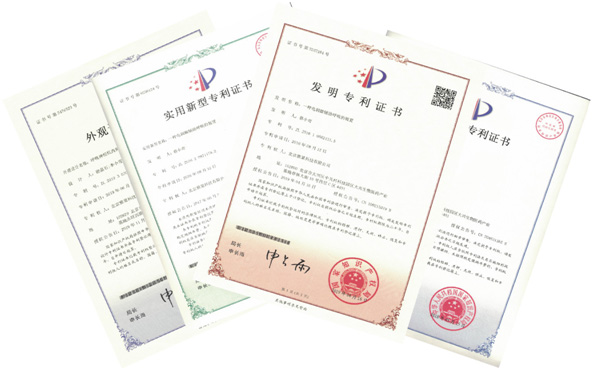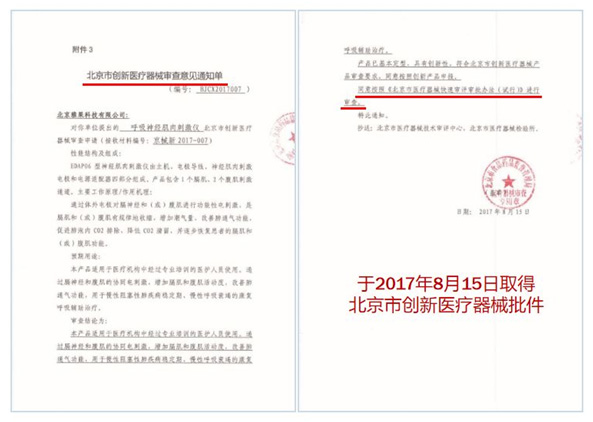Yaguo launches an Innovative Medical Device
Yaguo launches an Innovative Medical
Device-"Respiratory Power" Respiratory Neuromuscular Stimulator
January 17th, 2020
At the beginning of Chinese New Year,
Beijing Yaguo Technology Co., Ltd.'s innovative medical device
"Respiratory Power" respiratory neuromuscular stimulator was
officially launched. "Respiratory power" has been established in 2015
as a core innovative product of Yaguo, Through 4 years of continuously efforts,
after research, demonstration, design, development, and clinical registration
it has been awarded in Beijing as a respiratory therapy device. The medical
device registration certificate issued by the Municipal Drug Administration is
officially on the market and will soon bring good news to must patients with
chronic obstructive pulmonary disease.
Chronology
November 2015, Respiratory neuromuscular stimulator was officially launched.
August 2017, Respiratory neuromuscular stimulator was rated as an innovative medical device by the Beijing Drug Administration.
April 2019, Respiratory neuromuscular stimulator successfully completed clinical trials.
September 2019, at the Annual Meeting of Respiratory Diseases of the Chinese Medical Association CTS2019, Tong Chaohui, Vice President of Beijing Chaoyang Hospital, released the results of clinical experiments.
December 2019, Respiratory neuromuscular stimulator obtained the medical device registration certificate issued by the Beijing Drug Administration.
Patents & Patients
-4 authorized patents have been granted, 1 international patent PCT and 3 invention patents

-Appraised as an innovative medical device by the Beijing Drug Administration

-Praised by patients
Mr. Li, 71 years old, was diagnosed with COPD back in 2005. Although he is doing treatments such as drug inhalation, his respiratory function is still decreasing year by year, which seriously affects his health and daily life. In September 2018, he participated in a clinical experiment and received Respiratory therapy stimulation for 20 days. As a result, his walking distance in 6 minutes increased from 445 meters to 610 meters after treatment. Mr. Li specially presented a banner with the phrase "Patient-centered, Service-oriented faith" to express his gratitude.
Another clinical experiment was tested to Mr. Xu, 73 years old he was also diagnosed with COPD in 2003 and has suffered it for almost two decades. During last years, his respiratory function has decreased to GOLD level 4 as well as going through respiratory failure. Thus, he decided to take part in a clinical trial on August 2018, furthermore after he received a Respiratory therapy stimulation for 20 days, symptoms such as respiratory failure improved significantly. Walking distance in 6 minutes increased from 456 meters to 621 meters after treatment. Because of this , Mr. Xu presented a banner with the phrase "Breathing Power, Rejuvenating New Life" to thank Yaguo for bringing him back to "Elegant Life" with innovative products.
Medical Significance
COPD prevention and treatment situation is the key
COPD is one of the most common chronic respiratory diseases in China. Data from “Chinese Adult Lung Health Study" shows a total number of patients with COPD in China is nearly 100 million. The prevalence of COPD among adults aged 20 in China is 8.6%, over 40 is 13.7%, and over 60 of the population has exceeded 27% and is still on rise. COPD has become a chronic disease that is "equivalent to hypertension" and diabetes. Data from the World Health Organization show that COPD mortality rate ranks first in china and becomes the third leading cause of death for residents in all over the world.
At present, the treatment of COPD mainly relies on drugs such as bronchodilators. However, drug treatment can only reduce respiratory resistance and cannot prevent the decline in respiratory muscle function. Respiratory rehabilitation allows patients to benefit more from breathing dynamics by exercising their breathing muscles. The COPD manual issued by the National Institute of Clinical and Health Excellence (NICE) recommends that all patients with COPD participate in a respiratory rehabilitation program, stressing that neuromuscular electrical stimulation is a new strategy for pulmonary rehabilitation, especially for patients with severe chronic respiratory diseases.
Respiratory neuromuscular stimulator is a new type of physical therapy for COPD. There are two phases of breathing: inhalation and exhalation. The more prominent problem of COPD patients is exhalation dysfunction. The current physical therapy of COPD is mainly an external diaphragm pacemaker, which can only stimulate when inhaling. Diaphragm, unable to improve COPD retention and COD retention. The respiratory neuromuscular stimulator provides a biphasic, closed-loop feedback electrical stimulation that can help patients improve both inspiratory and expiratory functions, and synchronize the electrical stimulation with the patient's breathing through sound and light prompts for better results.
Clinical validation
Clinical experiment proves that therapeutic effect of respiratory neuromuscular stimulator is better than any other existing product. On September 6, 2019, at the CTS2019 Annual Meeting of Respiratory Diseases of the Chinese Medical Association, during Pulmonary Rehabilitation Physical Therapy Satellite Symposium, the Vice President Tong Zhaohui of Beijing Chaoyang Hospital affiliated to Capital Medical University released the results of heavy clinical trials:
120 randomized, parallel controlled clinical trials conducted by three research centers: Beijing Chaoyang Hospital, Tianjin Chest Hospital, and First Hospital of Hebei Medical University, affiliated to Capital Medical University, the results showed that prior trial the experimental group barely received respiratory neuromuscular stimulator therapy. In patients with pulmonary obstruction, after 4 weeks of treatment, the patient's diaphragm muscle activity increased to varying degrees, pulmonary function indicators such as maximum minute ventilation and arterial oxygen pressure were significantly improved.
Changes in patients with dyspnea score:
|
Group |
Time |
mMRC(Minutes) |
|
Experimental Group |
Before treatment |
1.63±0.74 |
|
|
After treatment |
1.33±0.61 |
|
|
p |
0.026 |
|
Control Group |
Before treatment |
1.65±0.66 |
|
|
After treatment |
1.42±0.56 |
|
|
p |
0.425 |
|
|
|
|
|
Time |
Group |
mMRC(Minutes) |
|
After treatment |
Experimental Group |
1.33±0.61 |
|
|
Control Group |
1.42±0.56 |
|
|
p |
0.454 |
Comparison within the group:
The mMRC score of the patients in the experimental group was significantly
reduced after treatment, and there was a significant statistical difference (P
<0.05).
Comparison between groups:
There was no statistical difference in mMRC score between the experimental
group and the control group after treatment.
Changes in 6-minute walking distance of patients:
|
Group |
Time |
6-Minutes’ walk distance (Meters) |
|
Experimental Group |
Before treatment |
425.4±59.74 |
|
|
After treatment |
490.93±72.56 |
|
|
p |
0.0000007 |
|
Control Group |
Before treatment |
439.03±54.42 |
|
|
After treatment |
465.69±52.73 |
|
|
p |
0.007 |
|
|
|
|
|
Time |
Group |
mMRC(Minutes) |
|
After treatment |
Experimental Group |
490.93±72.56 |
|
|
Control Group |
465.69±52.73 |
|
|
p |
0.035 |
Comparison within the group:
The six-minute walking distance between the two groups of patients increased after
treatment, and there was a significant statistical difference (P <0.05)
Comparison between groups:
The experimental group can significantly improve the patient's six-minute
walking distance than the control group, with significant statistical differences
(P <0.05)
The average 6-min walk distance (6 MWD) increased from 425 meters to 490 meters, an average increase of 65 meters, far exceeding the existing product's 25 meters, fully proving the safety and reliability of the latest COPD physical therapy method Effectiveness.
Respiratory neuromuscular stimulator characteristics
Respiratory neuromuscular stimulator provides a respiratory biphasic, closed-loop feedback electrical stimulation. Stimulate the phrenic nerve during inhalation, make the diaphragm contract regularly, increase mobility, and improve ventilation function; stimulate the rectus abdominis and external oblique muscles during exhalation, increase the expiratory or cough airflow, promote the discharge of CO2, assist the exhalation and Expectoration. And through the acousto-optic closed-loop feedback, the electrical stimulation is synchronized with the patient's spontaneous breathing, making the treatment process more comfortable and efficient.
Its main features include:
Effective Biphasic stimulation effective
The diaphragm and abdominal muscles are the main components of the respiratory muscles. The diaphragm contracts during inhalation and the abdominal muscle contracts during exhalation. The respiratory neuromuscular stimulator provides biphasic stimulation of the breath, which stimulates the phrenic nerve during the inspiratory phase to increase the amplitude of diaphragm muscle activity and increase the tidal volume; the expiratory phase stimulates the rectus abdominis and the oblique external abdomen, increases intraabdominal pressure, and promotes CO2 in the alveoli Exhaust, reduce CO2 retention, assist exhalation and sputum.
Acousto-optic feedback
Individual breathing parameters can be set according to the patient's inspiratory and exhaling rhythm. During electrical stimulation, the respiratory neuromuscular stimulator keeps the electrical stimulation synchronized with the patient's spontaneous breathing through the closed-loop feedback of breathing dynamic map changes and voice prompts, making the treatment process more comfortable and efficient.
Constant current output reduces sting
Respiratory neuromuscular stimulators use constant current electrical stimulation to penetrate the skin more easily and act on deep muscles and nerves, while avoiding skin tingling sensations caused by constant pressure electrical stimulation.
Independent adjustment
Respiratory neuromuscular stimulator has 6 channels of independent adjustment function, and can choose the diaphragm or abdominal muscle treatment channel independently, and the treatment options are diversified.
Super long battery life and strong adaptability
Respiratory neuromuscular stimulator is equipped with a 3400mAh battery pack, which has a battery life of 10 hours, which can meet a routine treatment of 20 people. The portable design can adapt to more complex and changing medical environmental conditions.
Data management Precision treatment
Respiratory neuromuscular stimulator records several parameter settings of each patient’s treatment without repeated input, which is convenient to retrieve. Patient historical treatment data can also be viewed to facilitate data management and help doctors to formulate more reasonable individualized and precise treatment plans for patients.
Broad application prospects
Respiratory neuromuscular stimulators are mainly used in respiratory rehabilitation as an Electrotherapy Device and chronic disease management. It can also be widely used in cardiology, cardiothoracic surgery, neurology, neurosurgery, emergency department, general surgery and other clinical or functional departments. It important to mention ICU acquired weakness (ICU-AW) which is a common acquired neuromuscular dysfunction in critically ill patients. The probability of this disease in ICU patients is 25 to 100%, which is one of the more serious complications of ICU. Moreover ICU-AW will not only prolong ICU Dmechanical ventilation time and hospital stay and increase medical expenses, but also seriously affect patients' long-term quality of life and prognosis. Respiratory neuromuscular stimulator will shorten mechanical ventilation time for ICU-AW patients, and enable patients to be removed from the extubating as soon as possible. To point out other problems such as asthma, lung cancer, interstitial lung disease, respiratory failure, heart failure, thoracic and abdominal surgery caused by respiratory injury, sacral nerve injury, and sacral dysfunction can also be decreased by using respiratory neuromuscular stimulator.
Respiratory neuromuscular stimulator is the first product of Yaguo's layout of chronic respiratory diseases, and it is also one of the landmark products on the road of independent research and development of Yaguo. In addition, Yaguo wearable respiratory neuromuscular stimulator is also coming soon, which is convenient for patients to perform long-term rehabilitation treatment in community hospitals or homes. In the future, Yaguo's footsteps will not stop. Yaguo will continue to take the concept of "innovation, care and grace" as its goal, and strive to provide medical staff with more optimized airway management technology and respiratory treatment programs to relieve more patients Sickness, and improve patient’s lives!




